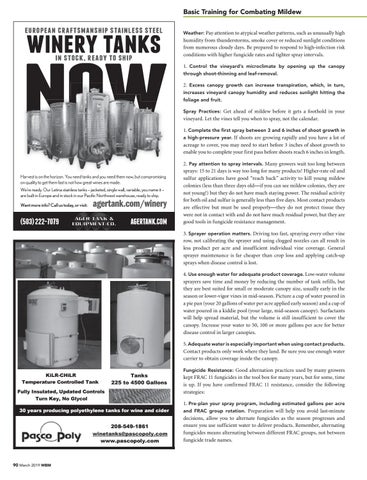Basic Training for Combating Mildew
european craftsmanship stainless steel
winery tanks
now in stock, ready to ship
Weather: Pay attention to atypical weather patterns, such as unusually high
humidity from thunderstorms, smoke cover or reduced sunlight conditions from numerous cloudy days. Be prepared to respond to high-infection risk conditions with higher fungicide rates and tighter spray intervals. 1. Control the vineyard’s microclimate by opening up the canopy through shoot-thinning and leaf-removal. 2. Excess canopy growth can increase transpiration, which, in turn, increases vineyard canopy humidity and reduces sunlight hitting the foliage and fruit. Spray Practices: Get ahead of mildew before it gets a foothold in your
vineyard. Let the vines tell you when to spray, not the calendar. 1. Complete the first spray between 3 and 6 inches of shoot growth in a high-pressure year. If shoots are growing rapidly and you have a lot of acreage to cover, you may need to start before 3 inches of shoot growth to enable you to complete your first pass before shoots reach 6 inches in length.
Harvest is on the horizon. You need tanks and you need them now, but compromising on quality to get them fast is not how great wines are made. We’re ready. Our Letina stainless tanks – jacketed, single wall, variable, you name it – are built in Europe and in stock in our Pacific Northwest warehouse, ready to ship. Want more info? Call us today, or visit:
agertank.com/winery
(503) 222-7079
AGERTANK.COM
2. Pay attention to spray intervals. Many growers wait too long between sprays: 15 to 21 days is way too long for many products! Higher-rate oil and sulfur applications have good “reach back” activity to kill young mildew colonies (less than three days old—if you can see mildew colonies, they are not young!) but they do not have much staying power. The residual activity for both oil and sulfur is generally less than five days. Most contact products are effective but must be used properly—they do not protect tissue they were not in contact with and do not have much residual power, but they are good tools in fungicide resistance management. 3. Sprayer operation matters. Driving too fast, spraying every other vine row, not calibrating the sprayer and using clogged nozzles can all result in less product per acre and insufficient individual vine coverage. General sprayer maintenance is far cheaper than crop loss and applying catch-up sprays when disease control is lost. 4. Use enough water for adequate product coverage. Low-water volume sprayers save time and money by reducing the number of tank refills, but they are best suited for small or moderate canopy size, usually early in the season or lower-vigor vines in mid-season. Picture a cup of water poured in a pie pan (your 20 gallons of water per acre applied early season) and a cup of water poured in a kiddie pool (your large, mid-season canopy). Surfactants will help spread material, but the volume is still insufficient to cover the canopy. Increase your water to 50, 100 or more gallons per acre for better disease control in larger canopies. 5. Adequate water is especially important when using contact products. Contact products only work where they land. Be sure you use enough water carrier to obtain coverage inside the canopy. Fungicide Resistance: Good alternation practices used by many growers
KiLR-CHiLR Temperature Controlled Tank
Tanks 225 to 4500 Gallons
Fully Insulated, Updated Controls Turn Key, No Glycol 30 years producing polyethylene tanks for wine and cider
208-549-1861 winetanks@pascopoly.com www.pascopoly.com
90 March 2019 WBM
kept FRAC 11 fungicides in the tool box for many years, but for some, time is up. If you have confirmed FRAC 11 resistance, consider the following strategies: 1. Pre-plan your spray program, including estimated gallons per acre and FRAC group rotation. Preparation will help you avoid last-minute decisions, allow you to alternate fungicides as the season progresses and ensure you use sufficient water to deliver products. Remember, alternating fungicides means alternating between different FRAC groups, not between fungicide trade names.
